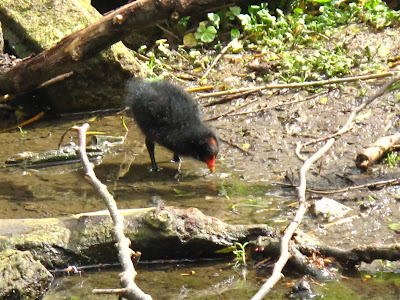A scorching sunny day at East Park. Thirsty Swallows and Swifts deftly swoop down to drink on the lake surface. As we arrive by the lake side we watch a young Coot calls its parents (above). Near the first island, we stop to watch a pair of Grebes, each adult in charge of a young one, of surprisingly different sizes. One of them seem intent of teaching the juvenile how to fish, and mostly ignores its calls, encouraging the chick to dive behind him. When the adult surfaces away from the young, they call them with Gannet-like, hoarse barks. One of the adults stops to groom itself, and the young does the same.
I see the first Rook I've seen in East Park, also trying to get to drink.
In the waterfront side, a flock of 10 or more Lesser Black Backed gulls feed on bread.
Great Crested grebe adult and grown chick
The chick swimming to meet its parent
Grooming time
This coot nest was so full of rubbish, they seem to select the rubbish themselves to 'adorn' the nest
A very confiding squirrel - although it nipped my finger!
Carrion Crow and Rook ready to drink
Mating Coots, pity about the railings, but I dared not stand up, as I had followed the whole courtship. The female greeted the male by turning her head toward her belly as he approached.
- Blackbird, carrying feather
- Blue Tit
 , chicks calling from inside a tree stump and parents busy going in and out
, chicks calling from inside a tree stump and parents busy going in and out - Canada Goose

- Carrion Crow

- Chaffinch S
- Collared Dove

- Coot
 , fledglings in different sizes
, fledglings in different sizes - Dunnock

- Feral Pigeon

- Goldfinch

- Great Crested Grebe 4 fledglings in two families
- Great Tit

- Greylag Goose

- Herring Gull

- House Sparrow

- Lesser Black-backed Gull c10
- Long-tailed Tit

- Magpie

- Mallard

- Moorhen

- Mute Swan 1
- Robin
 singing
singing - Rook

- Starling fledgling
- Swallow
- Swift

- Tufted Duck

- Woodpigeon
 B
B - Wren
 singing
singing






































